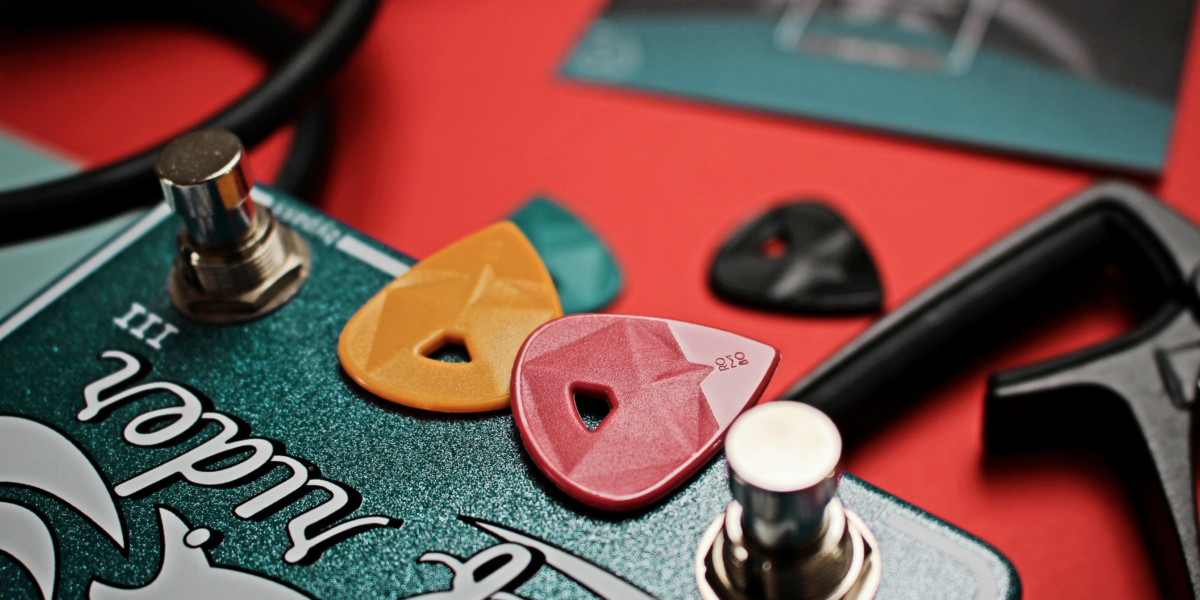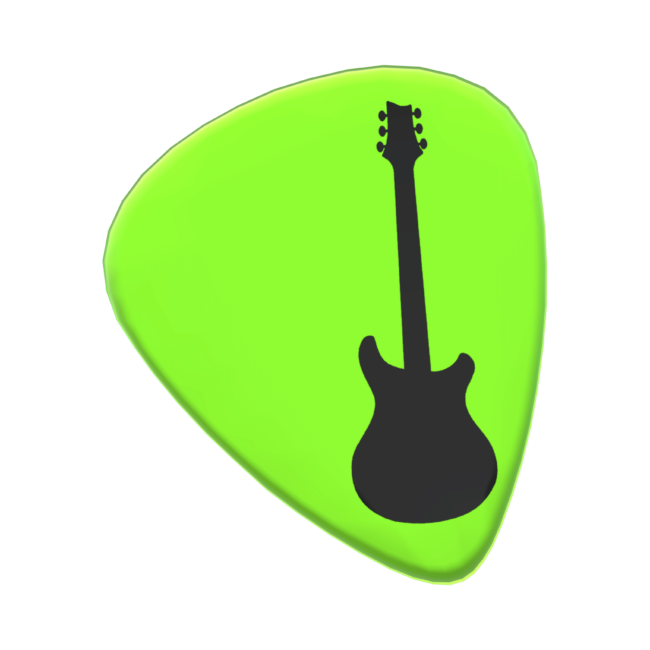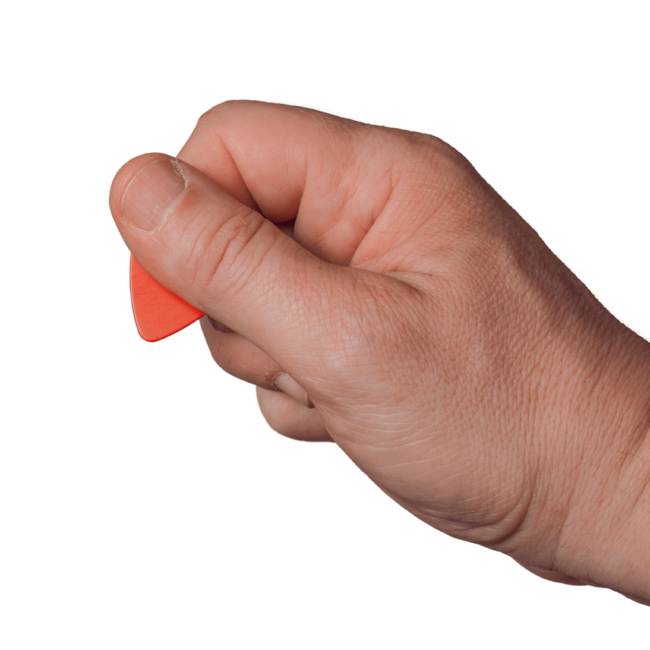How To Properly Hold And Use a Guitar Pick

Do you know how to hold a guitar pick or use one? This article covers everything you need to know about these handy guitar accessories.
On the surface, a guitar pick hardly seems to have depth. It’s just a piece of plastic that guitarists use to pluck strings.
However, picks have come a long way in the past century. With abundant resources, greater manufacturing capabilities, and tons of new designs, there are many factors to consider when choosing which pick(s) suits your needs.
Discover the various types of picks available, the advantages and disadvantages they bring to the table, and, ultimately, which ones you should try.

What is a guitar pick?
A guitar pick, plectra, or plectrum is a small, triangular-shaped piece of material that we use as a tool to pluck the strings of a guitar.
They come in all shapes and sizes, and manufacturers use different materials to produce guitar picks of varying thicknesses and textures. Different designs enable guitarists to play different styles with more proficiency.
Why should you use a guitar pick?
We’ve all seen them–those masterful guitarists plucking strings with multiple fingers, creating music that moves our hearts and stimulates our imagination.
Why should you use one if it’s possible to serenade people without a pick?
Plucking with your fingers works better for specific play styles. For instance, fingers have a softer touch, allowing you to play softer sounds and pluck many strings simultaneously.
However, the same is true for guitar picks. They offer musicians more precision than fingers. They make strumming and picking strings easier and help to create a louder, clearer, and cleaner sound.
The different types of guitar picks.
Originally, picks were made of feather quills and tortoise shells. At the turn of the 20th century, celluloid became popular because of its abundance and convenience.
Today, pick designs are more diverse. Guitars have developed considerably over the years, but the same is true for picks.
When it comes to finding the right pick for your needs, there are a few qualities to consider, like material, shape, grip, and thickness.
Material
People use a wide range of materials to design and create guitar picks. Some materials offer a smoother playing experience, while others provide longevity. Of course, some options offer a bit of both.
- Celluloid picks allow guitarists to create brighter and crisper tones. They tend to be flexible and durable.
- Acrylic is tough, light, clear, and durable, and you can easily mold and cut them to virtually any shape or thickness you want. Their versatility makes them great for various play styles.
- Nylon picks have a smooth surface. Therefore, producers add a high-friction coating to them. They’re ideal for precision playing and creating bright sounds.
- Delrin/Tortex is a heavy-duty plastic. They’re durable and easy to mold to the thickness and shape you want.
- Ultex is hard plastic, and while it’s durable, there’s no flexibility. This creates a sensation of increased resistance. It makes playing chords smoother and adds articulation to lead roles.
- With Carbon Fiber, there’s a trade-off. They offer guitarists a fantastic playing experience because you can make them lightweight, thin, and rigid. However, they don’t last as long as other options.
- Stone picks are typically made with jade, agate, or jasper. Because of their density, they’re durable. They’re also beautiful and easy to grip.
- Wood and fine wood picks are easy to maintain and tend to be thicker. However, because you can sand them down, they can create bright and warm tones.
- Metal is an uncommon choice. While the picks are rigid, they tend to erode the strings on your guitar. However, they’re great for playing lead guitar and articulating notes.
When selecting a pick material, you must consider your budget and play style. Each material offers pros and cons.
Shape
Another factor to consider when buying a pick is its shape. The various shapes that guitar picks can take are impressive.
- Standard guitar picks look like rounded triangles. They’re the most common shape and offer guitarists a smooth strumming and picking experience.
- Jazz III picks a similar to standard picks, except they have a sharper point and a round top. This makes them better suited for strumming to face-paced music like metal.
- Sharp Point picks take things a step further, allowing you to glide over strings. Although, because there’s less friction between pick and string, sound projection takes a hit.
- Triangle Shaped picks offer musicians more control. They tend to be a favorite choice for bassists.
- Picks with a Teardrop design offer more accuracy and speed and create a warmer tone.
- Finger and Thumb picks are peculiar. Some are for thumbs, and others for fingers. They allow you to strum and offer your other fingers the freedom to pluck other strings.
- The Shark Fin pick’s design is to enhance your speed picking and strumming. However, holding and playing with them can be tricky–they’re not ideal for beginners.
- Possibly the coolest and most versatile pick is the Dragon Heart. They’re perfect for guitarists who switch between lead and rhythm roles with a round, pointed edge.
Grip and thickness
The grip and thickness of your guitar pick also change how you play and the sounds you create.
There are five standard thicknesses:
- Extra light–0.40 mm and under.
- Light–0.41 mm to 0.63 mm.
- Medium–0.64 mm to 0.86 mm.
- Thick or heavy–0.87 mm to 1.2 mm.
- Extra-heavy–1.21 mm and over.
The thickness of a pick also affects the sound projection of your instrument.
Generally, thinner picks glide over the strings without grabbing them too much. They’re ideal for playing quickly. Because of that, they’re easier on the fingers and are better for playing quieter sounds.
Thicker picks, however, create a lot more friction with the strings. Therefore, they increase the volume coming from your instrument, making them ideal for heavier music. However, because of the increased tension between pick and string, your fingers must be strong to play for extended periods.
Are guitar picks suitable for beginners?
Guitar picks are a good beginner tool because they help grip and accuracy when playing. Although, within the realm of picks, some are better suited for beginners than others.
When you’re beginning your guitar journey, your brain and fingers have a lot to juggle between picking, strumming, and playing notes and chords. So picks like the finger and thumb or dragon heart aren’t ideal.
We recommend you get a thin to medium-sized pick and stick to a standard shape. This way, you can strum and pick relatively easily and focus on building those skills without additional techniques to worry about.
How to properly hold a guitar pick.
To get the most out of your guitar pick, you must know how to use it. Although, before looking at how to hold a guitar pick, consider: do you know how to hold a guitar?
For the most part, it’s intuitive. Read our blog, How to Hold a Guitar Properly: The Definitive Guide, for a precise breakdown

To hold a guitar pick, place it between your thumb and first two fingers with a light grip. The pointy end should be facing the strings or away from your hand.
You can adjust your grip on the pick. Some picks require a firmer touch. Make sure you hold it securely so it doesn’t slip out of your hand.
It’s about finding the right balance. You got this!
How to play with a guitar pick.
Now that you have a firm grip on the pick, you can begin plucking the guitar strings.
Position your hand over the sound hole of your acoustic or over the body of your electric guitar. Don’t rest your hand on your instrument. You want to hover near the strings, giving you the mobility you need to play.
When strumming and picking, you want to be relaxed and have a looseness in your wrist. It’s essential that the movement comes from your wrist and not your arm. Your wrist should be rotating smoothly.
Guitar picks are an essential accessory for any guitarist, whether you’re a beginner or a pro. They allow you to strum and pick with precision and project your sound with more volume.
Pick the right app.
Tools like a pick can seriously boost your guitar playing. Another essential accessory to have in your toolbox is a guitar app. Finding time to play your instrument can be tricky, yet it’s vital to get some time in every day–even if it’s just five minutes. Simply guitar provides short lessons, allowing you to progress at a pace that works for you. Give it a try today.









